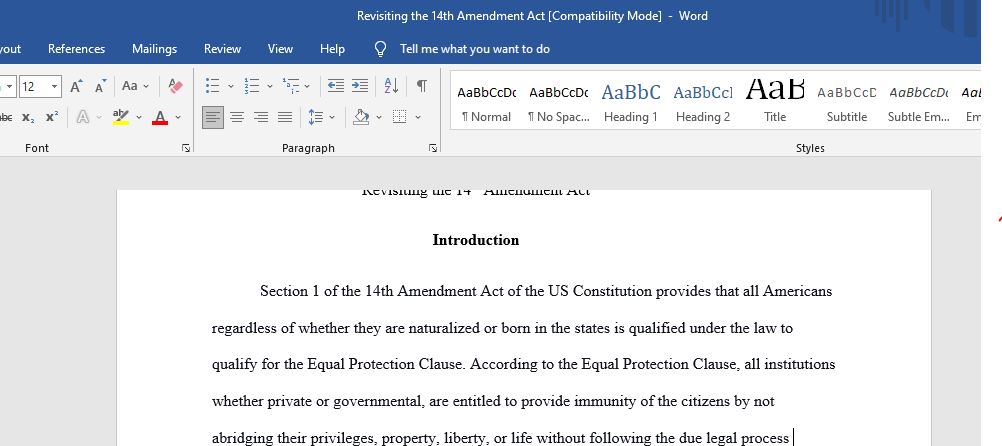Evaluate revisiting the 14th amendment Act.
Paper topic: Equal Protection clause
I. Introduction & Background
A. Introduction
I have chosen to discuss the Equal Protection clause from the 14th Amendment, which serves to
protect the privileges and rights of all Americans equally, either born or naturalized. This is a
significant clause as it reinforces the message that all Americans should be treated fairly and just,
even those that were not born here.
However, my thesis will show that the Equal Protection Clause has been favoring ethnic
minorities over the years.
II. First writing prompt
A. The chosen clause is taken from the 14th Amendment; ‘’Citizen rights not to be abridged’’
(otherwise known as the Equal Protection clause). Hamilton, Madison, and Jay provide the
following summary of the clause in their 1788 Federalist paper and their significance as it
reinforces the message that all citizens (either born or later naturalized) should be treated equally
and have access to the same privileges.
III. Second writing prompt
A. The University of California Medical School, due to its affirmative efforts, reserves the
right to hold 16 percent of its spaces for minority groups only. Allan Bakke, a white citizen of the
United States, had applied to the school but was unsuccessful on two occasions (Legal
Information Institute). In his efforts to secure the place at the program, Bakke provided evidence
of his grades, which ‘’excelled any of that of the minority applicants’.’’ He filed a suit against the
school, arguing that he ‘’was denied the right to study at the University based entirely on his
race.’’ (Legal Information Institute) Bakke argued that this was against the Equal Protection
clause from the 14th Amendment. The Supreme Court ordered for the University to admit
Bakke, reasoning that the University’s strict admission rules were unconstitutional. Justice Lewis
Powell Junior ruled that the University had mistreated Bakke against other fellow applicants and
said that severe racial discrimination of applicants (either positive or negative) violates the Equal
Protection Clause.
IV. Third writing prompt
A. At first, the verdict appears to be victorious for everyone. However, upon closer inspection
from past research, it appears evident that the affirmative action (or ‘positive’
discrimination/favoritism towards certain races) is a much more complex issue. For instance, the
Supreme Court had approved Harvard’s admissions program criteria (among others), which
states that applicants’ race will be considered in order to achieve diversity in education (Alleyne,
1981). By approving such law, the Court is suggesting that one racial group will be favored
against the other to achieve diversity, at the same time, discriminating against the white
American citizens of their rights. Interestingly, the Court doesn’t mention that Harvard’s student
body is made up of just 14 percent African Americans and 12 percent Hispanics (Finke, 1989),
which is far from diverse.
Secondly, the analysis of Justice Powell’s previous Equal Protection cases shows distinct
favoritism towards minorities. Upon analysis of cases such as Lau v Nichols, 1974, we discover
that Justice Powell argued that the school did violate the Equal Protection clause by not
providing non-English speaking students with instructions in their native language (O’Neill,
1979). He argued that these were legislative and administrative discriminations. This goes
against not only the Bakke case but also the Equal Protection clause, as Justice Powell had
rejected the claim that the school practices double standards with regards to racial favoritism.
V. Conclusion & Future Research
A. Closing
1. Analysis of the previous research provides clear examples of the Equal Protection clause
favoring minorities, although diversity still has not been reached for these groups in the
educational space.
B. Future Research
1. However, an analysis of more recent Court cases would provide a better understanding of
whether the Equal Protection clause is practiced fairly or whether favoritism still exists.

word limit:1500
